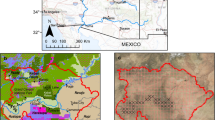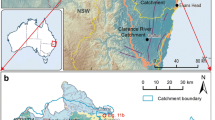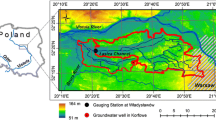Abstract
Groundwater recharge sets a constraint on aquifer water balance in the context of water management. Historical data on groundwater and other relevant hydrological processes can be used to understand the effects of climatic variability on recharge, but such data sets are rare. The climate of the Canadian prairies is characterized by large inter-annual and inter-decadal variability in precipitation, which provides opportunities to examine the response of groundwater recharge to changes in meteorological conditions. A decadal study was conducted in a small (250 km2) prairie watershed in Alberta, Canada. Relative magnitude of annual recharge, indicated by water-level rise, was significantly correlated with a combination of growing-season precipitation and snowmelt runoff, which drives depression-focussed infiltration of meltwater. Annual precipitation was greater than vapour flux at an experimental site in some years and smaller in other years. On average precipitation minus vapour flux was 10 mm y−1, which was comparable to the magnitude of watershed-scale groundwater recharge estimated from creek baseflow. Average baseflow showed a distinct shift from a low value (4 mm y−1) in 1982–1995 to a high value (15 mm y−1) in 2003–2013, indicating the sensitivity of groundwater recharge to a decadal-scale variability of meteorological conditions.
Résumé
La recharge de l’aquifère exerce une contrainte sur le bilan de nappe dans le contexte de la gestion de l’eau. Les données historiques sur l’aquifère et sur les autres processus hydrologiques associés peuvent être utilisées pour comprendre les effets de la variabilité climatique sur la recharge, mais de tels ensembles de données sont rares. Le climat des prairies canadiennes est caractérisé par une grande variabilité des précipitations interannuelles et inter-décadaires, ce qui fournit des opportunités pour examiner la réponse de la recharge des eaux souterraines aux modifications des conditions météorologiques. Une étude décadaire a été menée sur un petit bassin versant prairial (250 km2) en Alberta (Canada). L’importance relative de la recharge annuelle, indiquée par l’élévation du niveau de l’eau, a été corrélée de façon significative avec une combinaison des précipitations de début de saison et l’écoulement dû à la fonte des neiges, qui entraîne une infiltration d’eau de fonte dans les dépressions. Sur un site expérimental, le volume annuel de précipitation a été supérieur au volume d’évaporation durant quelques années et inférieur durant quelques autres. En moyenne, le volume de précipitation diminué du volume d’évaporation a été de 10 mm a−1, valeur comparable à la hauteur de recharge des eaux souterraines à l’échelle du bassin versant estimée à partir du débit de base d’un ruisseau. Le débit de base moyen a nettement varié depuis une valeur basse (4 mm a−1) en 1982–1995 jusqu’à une valeur élevée (15 mm a−1) en 2003–2013, indiquant la sensibilité de la recharge des eaux souterraines à la variabilité des conditions météorologiques à l’échelle décadaire.
Resumen
La recarga de agua subterránea determina una limitante para el balance de agua de un acuífero en el contexto del manejo del agua. Se pueden usar datos históricos sobre agua subterránea y otros procesos hidrológicos relevantes para entender los efectos de la variabilidad climática sobre la recarga, pero tales conjuntos de datos son poco común. El clima de las llanura en Canadá se caracteriza por un gran variabilidad interdecádica y anual en las precipitaciones, lo cual proporciona oportunidades para analizar la respuesta de la recarga de agua subterránea a cambios en las condiciones meteorológicas. Se realizó un estudio decádico en una pequeña cuenca de llanura en Alberta, Canadá. La magnitud relativa de la recarga anual, indicada por la elevación de los niveles de agua, fue correlacionada significativamente con la combinación del crecimiento estacional de la precipitación y el escurrimiento por derretimiento de nieve, lo cual lleva a una infiltración focalizada de agua de derretimiento en las depresiones. La precipitación anual fue mayor que el flujo de vapor en un sitio experimental en algunos años y menor en otros. El promedio de la precipitación menos el flujo de vapor fue 10 mm y−1, lo cual era comparable a escala de cuenca con la magnitud de la recarga de agua subterránea estimada a partir de flujo base del arroyo. El flujo de base mostró un cambio marcado desde valores bajos (4 mm y−1) en 1982–1995 a valores altos (15 mm y−1) en 2003–2013, lo cual indica la sensibilidad de la recarga de agua subterránea a una variabilidad de las condiciones meteorológicas a escala decádica.
摘要
在水管理中,地下水补给为含水层水平衡设置了约束条件。地下水和其它相关水文过程的历史资料可用于了解气候变化对补给的影响,然而,这样的资料非常匮乏。加拿大大草原的气候特征是一年间及十年间的降水变化非常大,这为查验地下水补给对气象条件变化的响应提供了机会。在加拿大亚伯达省一个小的牧场(250 km2)进行了为期10年的研究。地下水位的上升能够表明显示出每年相对补给量,每年的相对补给量与生长季节的降水和融雪水径流对应良好,融雪水径流可促使融水在低洼地带集中入渗。试验场年降水量有些年份大于蒸气通量,有些年份少于蒸气通量。通常降水量减去蒸气通量为10 mm y−1,这个量与根据小溪基流量估算得出的流域尺度的地下水补给量旗鼓相当。1982年至1995年平均基流量很低((4 mm y−1),然而,2003年至2013年平均基流量却很高,表明地下水补给对十年尺度的气象条件变化非常敏感。
Resumo
No contexto da gestão dos recursos hídricos, a recarga de águas subterrâneas tem implicações importantes para o balanço hídrico nos aquíferos. Para se perceber o efeito da variabilidade climática na recarga, podem ser usados dados históricos sobre águas subterrâneas e sobre outros processos hidrológicos relevantes, mas estes dados são ainda raros. O clima das pradarias canadianas é caraterizado por uma grande variabilidade interanual e inter-década da precipitação, o que proporciona oportunidades excelentes para se examinar a resposta da recarga de aquíferos à mudança das condições meteorológicas. Foi desenvolvido um estudo à escala da década para uma pequena bacia hidrográfica (250 km2) na pradaria de Alberta, Canadá. O valor da recarga anual, indicado pela subida do nível freático, foi correlacionado com a combinação da precipitação (na estação das culturas) e com o degelo, que implica infiltração da água do degelo nas zonas baixas. A precipitação anual foi superior ao fluxo de vapor (evapotranspiração) em alguns anos, sendo menor noutros. Para precipitações médias, a diferença para o fluxo de vapor foi de 10 mm a−1, o que foi considerado comparável ao escoamento de base nos ribeiros, proveniente da recarga à escala da bacia. O escoamento de base mostrou uma mudança a partir de valores baixos (4 mm a−1) de 1982 a 1995 até um valor mais elevado (15 mm a−1) de 2003 a 2013, indicando a suscetibilidade da recarga dos aquíferos à variabilidade das condições climáticas à escala das décadas.














Similar content being viewed by others
References
Agriculture and Agri-Food Canada (AAFC) (2012) AAFC Watersheds Project - 2012. http://www.agr.gc.ca/eng/?id=1343313831597%23a3. Accessed June 6, 2014
Allison GB, Hughes MW (1983) The use of natural tracers as indicators of soil-water movement in a temperate semi-arid region. J Hydrol 60:157–173
Allison GB, Cook PG, Barnett SR, Walker GR, Jolly ID, Hughes MW (1990) Land clearance and river salinisation in the western Murray Basin, Australia. J Hydrol 119:1–20
Anochikwa CI, van der Kamp G, Barbour SL (2012) Interpreting pore-water pressure changes induced by water table fluctuations and mechanical loading due to soil moisture changes. Can Geotech J 49:357–366
Berthold S, Bentley LR, Hayashi M (2004) Integrated hydrogeological and geophysical study of depression-focused groundwater recharge in the Canadian prairies. Water Resour Res 40, W06505, doi:10.1029/2003WR002982
Bosal B, Regier M (2007) Historical comparison of the 2001/2002 drought in the Canadian Prairies. Clim Res 33:229–242
Bredehoeft JD (2002) The water budget myth revisited: why hydrogeologists model. Ground Water 40:340–345
Burns ER, Bentley LR, Hayashi M, Grasby SE, Hamlin AP, Smith DG (2010) Hydrogeological implications of paleo-fluvial architecture for the Paskapoo Formation, SW Alberta: a stochastic analysis. Hydrogeol J 18:1375–1390
Chen Z, Grasby SE, Osadetz KG (2004) Relation between climate variability and groundwater levels in the upper carbonate aquifer, southern Manitoba, Canada. J Hydrol 290:43–62
Crosbie RS, Scanlon BR, Mpelasoka FS, Reedy RC, Gates JB, Zhang L (2013) Potential climate change effects on groundwater recharge in the High Plains Aquifer, USA. Water Resour Res 49:3936–3951
de Vries JJ, Simmers I (2002) Groundwater recharge: an overview of processes and challenges. Hydrogeol J 10:5–17
Dingman SL (2002) Physical hydrology. Prentice-Hall, Upper Saddle River, NJ, 646 pp
Ehsanzadeh E, Spence C, van der Kamp G, McConkey B (2012) On the behaviour of dynamic contribution areas and flood frequency curves in North American Prairie watersheds. J Hydrol 414–415:364–373
Elliott JA, Efetha AA (1999) Influence of tillage and cropping system on soil organic matter, structure and infiltration in a rolling landscape. Can J Soil Sci 79:457–463
Environment Canada (2014) Canadian climate normals. http://climate.weather.gc.ca/climate_normals/index_e.html. Accessed Mar 14, 2014
Gleeson T, Wada Y, Beirkens MFP, van Beek LPH (2012) Water balance of global aquifers revealed by groundwater footprint. Nature 488:197–200
Godwin R, Martin F (1975) Calculation of gross and effective drainage areas for the Prairie Provinces. In: Proceedings of Canadian Hydrology Symposium, Winnipeg, August 1975, pp 219–223
Gonfiantini R (1981) The δ-notation and the mass-spectrometric measurement techniques. In: Stable isotope hydrology: deuterium and oxygen-18 in the water cycle. Gat JR, Gonfiantini R (eds) International Atomic Energy Agency technical report 210: Vienna, pp 35–84
Gray DM, Toth B, Zhao L, Pomeroy JW, Granger RJ (2001) Estimating areal snowmelt infiltration into frozen soils. Hydrol Process 15:3095–3111
Green TR and seven others (2011) Beneath the surface of global change: Impacts of climate change on groundwater. J Hydrol 405:532–560
Grieef LA (2006) Establishing a groundwater monitoring network using rural wells in the West Nose Creek watershed, Alberta. MSc Thesis, University of Calgary, AB, Canada, 125 pp
Grieef LA, Hayashi M (2007) Establishing a rural groundwater monitoring network using existing wells: West Nose Creek pilot study, Alberta. Can Water Res J 32:303–314
Hamblin AP (2004) Paskapoo-Porcupine Hills formations in western Alberta: synthesis of regional geology and resource potential. Open File 4679, Geological Survey of Canada, Ottawa
Hanesiak JM, Stewart RE, Bonal BR et al (2011) Characterization and summary of the 1999–2005 Canadian Prairie drought. Atmosphere–Ocean 49:421–452
Hayashi M, van der Kamp G, Schmidt R (2003) Focused infiltration of snowmelt water in partially frozen soil under small depressions. J Hydrol 270:214–229
Hayashi M, Jackson JF, Xu L (2010) Application of the Versatile Soil Moisture Budget model to estimate evaporation from prairie grassland. Can Water Res J 35:187–208
Healy RW, Cook PG (2002) Using groundwater levels to estimate recharge. Hydrogeol J 10:91–109
Helsel DR, Hirsch RM (2002) Statistical methods in water resources. Techniques of Water-Resources Investigations, book 4, chapter A 3, US Geological Survey, Reston, VA, 509 pp
Hvorslev MJ (1951) Time lag and soil permeability in ground-water observations. Corps of Engineers, U.S. Army, Waterways Experiment Station 50, Vicksburg, MS
Hydrogeological Consultants Ltd. (2002) M.D. of Rocky View No. 44, Part of the South Saskatchewan River Basin Tp 021 to 029, R25 to 29, W4M & Tp 023 to 029, R01 to 06, W5M Regional Groundwater Assessment. M.D. of Rocky View and Agriculture and Agri-Food Canada, Hydrogeological Consultants, Edmonton, AB, 57 pp
Iwata Y, Hayashi M, Suzuki S, Hirota T, Hasegawa S (2010) Effects of snowcover on soil freezing, water movement and snowmelt infiltration: a paired plot experiment. Water Resour Res 46, W09504. doi:10.1029/2009/WR008070
Keller CK, van der Kamp G (1988) Hydrogeology of two Saskatchewan tills, II: occurrence of sulfate and implications for soil salinity. J Hydrol 101:123–144
Lambert A, Huang J, van der Kamp G et al (2013) Measuring water accumulation rates using GRACE data in areas experiencing glacial isostatic adjustment: The Nelson River basin. Geophys Res Lett 40:6118–6122
Lissey A (1971) Depression-focused transient groundwater flow patterns in Manitoba. Geol Assoc Can Spec Pap 9:333–341
Looney SW, Gulledge TR (1985) Use of the correlation coefficient with normal probability plots. Am Stat 39:75–79
Maulé CP, Chanasyk DS, Muehlenbachs K (1994) Isotopic determination of snow-water contribution to soil water and groundwater. J Hydrol 155:73–91
Mekis E, Vincent LA (2011) An overview of the second generation adjusted daily precipitation dataset for trend analysis in Canada. Atmosphere–Ocean 49:163–177
Mohammed GA, Hayashi M, Bentley LR, Wilkinson M (2011) Development of a coupled surface-groundwater model towards sustainable groundwater management in the Canadian prairies. Proceedings of the Joint Annual Meeting of the International Association of Hydrogeologists-Canadian National Chapter and the Canadian Quaternary Association, Quebec City, QB, August 2011, 6 pp
Mohammed GA, Hayashi M, Farrow CR, Takano Y (2013) Improved representation of frozen soil processes in the Versatile Soil Moisture Budget model. Can J Soil Sci 93:511–531
Nkemdirim LC (1996) Canada’s Chinook belt. Int J Climatol 16:441–462
Peng H, Mayer B, Harris SA, Krouse HR (2004) A 10-yr record of stable isotope ratios of hydrogen and oxygen in precipitation at Calgary, Alberta, Canada. Tellus 56B:147–159
Perez-Valdivia C, Sauchyn D, Vanstone J (2012) Groundwater levels and teleconnection patterns in the Canadian Prairies. Water Resour Res 48: doi:10.1029/2011WR010930
Scanlon BR, Reedy RC, Stonestrom DA, Prudic DE, Dennehy K (2005) Impact of land use and land cover change on groundwater recharge and quality in the southwestern US. Glob Chang Biol 11:1577–1593
Seyfried MS, Murdock MD (1997) Use of air permeability to estimate infiltrability of frozen soil. J Hydrol 202:95–107
Smith CD (2007) Correcting the wind bias in snowfall measurements made with a Geonor T-200B precipitation gauge and alter wind shield. 87th American Meteorological Society Annual Meeting, San Antonio, TX, January 13–18, 2007
Sophocleous M (2000) From safe yield to sustainable development of water resources: the Kansas experience. J Hydrol 235:27–43
van der Kamp G, Gale JE (1983) Theory of earth tide and barometric effects in porous formations with compressible grains. Water Resour Res 19:538–544
van der Kamp G, Hayashi M (1998) The groundwater recharge function of small wetlands in the semi-arid Northern Prairies. Great Plains Res 8:39–56
van der Kamp G, Hayashi M (2009) Groundwater-wetland ecosystem interaction in the semiarid glaciated plains of North America. Hydrogeol J 17:203–214
van der Kamp G, Hayashi M, Gallén D (2003) Comparing the hydrology of grassed and cultivated catchments in the semi-arid Canadian prairies. Hydrol Process 17:559–575
van Dijk T (2005) Depression-focused recharge and the impacts of land use on the hydrology of small depressions in Calgary, Alberta, MSc Thesis, University of Calgary, AB, Canada, 158 pp
Water Survey of Canada (WSC) (2014) Archived hydrometric database. http://www.wsc.ec.gc.ca/applications/H2O/. Accessed Apr 6, 2014
Winter TC (1989) Hydrologic studies of wetlands in the northern prairies. In: van der Valk A (ed) Northern prairie wetlands. Iowa State University Press, Iowa City, IA, pp 17–54
Zaitlin B, Hayashi M, Clapperton J (2007) Distribution of northern pocket gopher burrows, earthworms and effects on infiltration in a prairie landscape in Alberta, Canada. Appl Soil Ecol 37:88–94
Zebarth BJ, De Jong E, Henry JL (1989) Water flow in a hummocky landscape in central Saskatchewan, Canada, II: saturated flow and groundwater recharge. J Hydrol 110:181–198
Zhou Y (2009) A critical review of groundwater budget myth, safe yield and sustainability. J Hydrol 370:207–213
Acknowledgements
We thank the well owners for providing access to their wells and Rocky View County for assisting with the community-based monitoring program. We also thank numerous students and field technicians who participated in this project, in particular Lisa Grieef, Tim van Dijk, John Jackson, Jaclyn Schmidt, Nathan Green, Kate Forbes, Krystal Chin, Shelby Snow, Getachew Mohammed, and Kathleen Little. Funding for this project was provided by Alberta Environment, Alberta Ingenuity Centre for Water Research, Canada-Alberta Water Supply Expansion Program, Canada Foundation for Innovation, Canadian Foundation for Climate and Atmospheric Sciences (DRI Network), Royal Bank of Canada, Alberta Innovates - Energy and Environment Solutions, Natural Sciences and Engineering Research Council (CCRN Network), and Environment Canada Science Horizons Program. Constructive comments by two anonymous reviewers improved the quality of the paper.
Author information
Authors and Affiliations
Corresponding author
Rights and permissions
About this article
Cite this article
Hayashi, M., Farrow, C.R. Watershed-scale response of groundwater recharge to inter-annual and inter-decadal variability in precipitation (Alberta, Canada). Hydrogeol J 22, 1825–1839 (2014). https://doi.org/10.1007/s10040-014-1176-3
Received:
Accepted:
Published:
Issue Date:
DOI: https://doi.org/10.1007/s10040-014-1176-3




